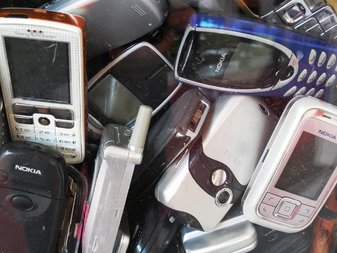Billions of Cellphones Polluting the World
 Once considered a status symbol, cellphones have become ubiquitous.There are now 6.8 billion mobile subscriptions worldwide, 800 million more than at the end of 2011.
Once considered a status symbol, cellphones have become ubiquitous.There are now 6.8 billion mobile subscriptions worldwide, 800 million more than at the end of 2011.But mobile technology poses serious environmental challenges, both because of the raw materials needed to produce the hardware and the pollution associated with disposal.
“As populations in emerging economies adopt similar technologies and lifestyles to those currently used in OECD countries, global metal needs will be three to nine times larger than all the metals currently used in the world,” according to Achim Steiner, executive director at the United National Environmental Programme.
The United Nations agency responsible for the environment warned that the rapid growth in the demand for metals requires major rethinking of current recycling models. The announcement came during a U.N.-sponsored conference in Berlin last week.
“A far more sophisticated approach is urgently needed to address the challenges of recycling complex products, which contain a broad variety of interlinked metals and materials,” said Mr. Steiner.
The recycling of electronic devices — and the reuse of the constituent metals — is notoriously difficult, partly because of the design of the technology contained in consumer devices. But recycling experts say that less energy is needed to recycle and reuse metals from consumer electronics than to mine for new metals (not to mention the human toll such mining has taken).
Ian Urbina reported last year on the difficulty of recycling the many cathode-ray tube monitors that have been replaced by new LED flat screens. Each of the old monitors contains up to eight pounds of lead, which can harm the environment if not disposed of correctly.
Over five years, Ian reported, the electronic waste stream in the United States has more than doubled.
Samsung said this week that some of its phones might contain new tin mined at Bangka Island in Indonesia, according to The Guardian. The island was the subject of an investigation last year by The Guardian and Friends of the Earth for child labor and unregulated and environmentally harmful mining practices.
Apple, the maker of the iPhone, and Samsung’s chief competitor on the Smartphone market, came under fire last year after quietly withdrawing from EPEAT, a registry of environmentally friendly electronics. The company rejoined the registry after consumer protests.
Here in Europe, the European Parliament approved stricter guidelines for electronic waste last year. By 2016 member countries must collect 45 tons of electronic waste for 100 tons of electronics sold in the previous three years. Depending on the countries’ commitments, the target for the electronic waste recuperation goes up to 65 or 85 percent by 2019, according to the new Waste Electrical and Electronic Equipment (or WEEE) guidelines.
Paradoxically, clean energy technology, which is also booming, has created a spike in demand for metal and the associated disposal problems.
“Product designers need to ensure that materials such as rare-earth metals in products ranging from solar panels and wind turbine magnets to mobile phones can still be recovered easily when they reach the end of their life,” said Mr. Steiner of the UNEP.
You can return to the main Market News page, or press the Back button on your browser.

